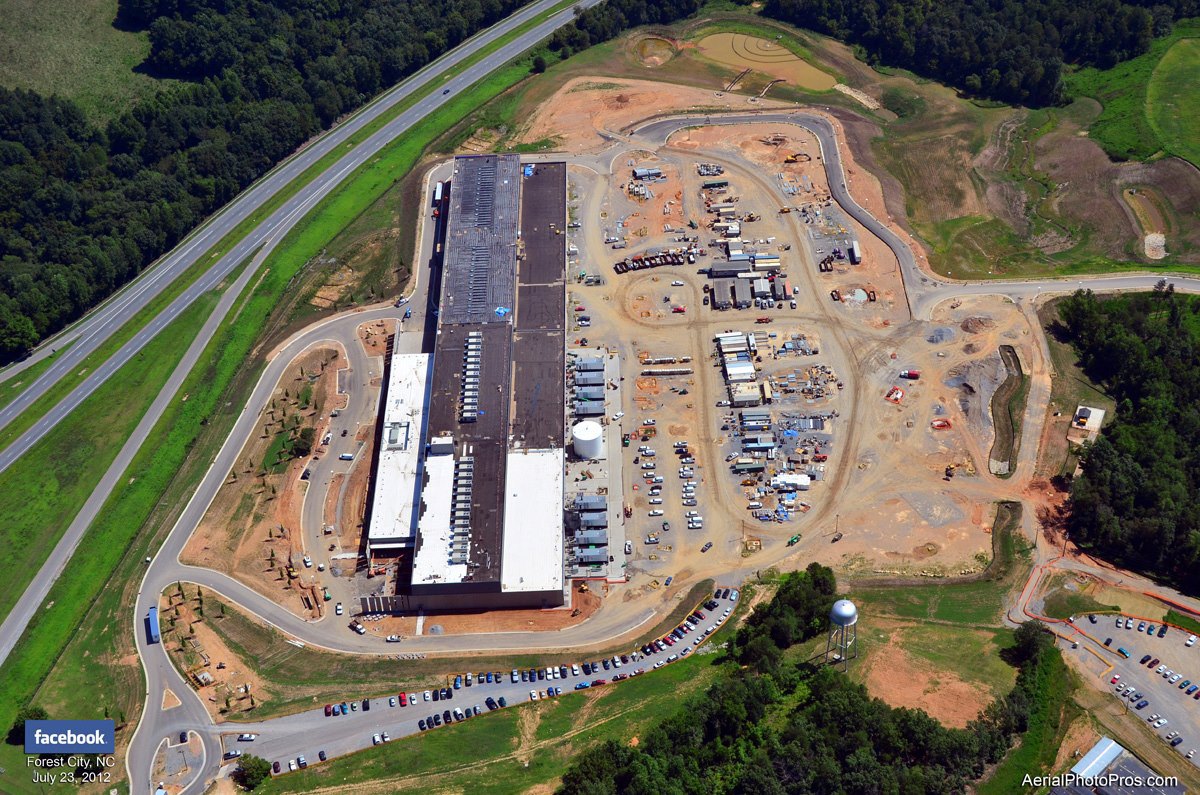Forest City, N.C., was once known as Burnt Chimney. But smokestacks are definitely a thing of the past, thanks to the social media giant Facebook, which is investing another $200 million to expand its data center campus there with a third, 480,000-sf building.
Construction reportedly is underway in Forest City, which lies between Asheville, N.C., and Greenville, S.C.
In a blog he posted on Facebook, Keven McCammon, the data center’s site manager, said that construction would add to a project that already has created “thousands of jobs in the regional economy and millions of dollars in economic impact.”
There’s no question that Facebook’s presence has been a boon to Forest City and its 7,400 local residents. The company invested $450 million into the first two buildings that each span 300,000 sf. RTI International, a firm Facebook retained to measure its economic impact, found that between 2011 and 2013 the data center had generated a total gross economic impact of $707 million and supported 5,000 jobs in North Carolina.
And since 2011, Facebook has awarded an estimated $575,000 to schools and qualified nonprofits in Rutherford County, where Forest City is located. Facebook recently agreed to support a pilot program to provide free WiFi access to 75 to 100 students in the local school district.
 Office space at Facebook's data center in Forest City.
Office space at Facebook's data center in Forest City.
Facebook, along with other tech companies, has favored North Carolina for its data center because of the state’s low-cost, reliable and available power, relatively inexpensive land, available water (at Forest City, Facebook is deploying evaporative cooling, which requires mist spray to cool the air as it enters the facility), proximity to East Coast customers, and generous tax incentives.
In June, Facebook announced plans to build a third data center on its campus in Altoona, Iowa, where its first data center there was already operational and a second was under construction. One month later, it broke ground on construction of a data center in Fort Worth, Texas, for which the company will invest $500 million in three 250,000-sf buildings. That data center, when it opens next year, will be powered entirely by wind power.
Facebook was the recipient of a $146.7 million incentive package from Fort Worth to locate its data center there. The Associated Press reports that state governments across the country over the past decade have extended nearly $1.5 billion in tax incentives to hundreds of data center projects initiated by various tech companies.
Facebook also has data centers in Pineville, Ore., and Lulea, Sweden.
Related Stories
| Nov 16, 2010
Calculating office building performance? Yep, there’s an app for that
123 Zero build is a free tool for calculating the performance of a market-ready carbon-neutral office building design. The app estimates the discounted payback for constructing a zero emissions office building in any U.S. location, including the investment needed for photovoltaics to offset annual carbon emissions, payback calculations, estimated first costs for a highly energy efficient building, photovoltaic costs, discount rates, and user-specified fuel escalation rates.
| Nov 9, 2010
12 incredible objects being made with 3D printers today
BD+C has reported on how 3D printers are attracting the attention of AEC firms. Now you can see how other creative types are utilizing this fascinating printing technology. Among the printed items: King Tut’s remains, designer shoes, and the world’s smallest Rubik’s Cube.
| Nov 5, 2010
New Millennium’s Gary Heasley on BIM, LEED, and the nonresidential market
Gary Heasley, president of New Millennium Building Systems, Fort Wayne, Ind., and EVP of its parent company, Steel Dynamics, Inc., tells BD+C’s Robert Cassidy about the Steel Joist Manufacturer’s westward expansion, its push to create BIM tools for its products, LEED, and the outlook for the nonresidential construction market.
| Nov 2, 2010
Energy Analysis No Longer a Luxury
Back in the halcyon days of 2006, energy analysis of building design and performance was a luxury. Sure, many forward-thinking AEC firms ran their designs through services such as Autodesk’s Green Building Studio and IES’s Virtual Environment, and some facility managers used Honeywell’s Energy Manager and other monitoring software. Today, however, knowing exactly how much energy your building will produce and use is survival of the fittest as energy costs and green design requirements demand precision.
| Oct 13, 2010
Test run on the HP Z200 SFF Good Value in a Small Package
Contributing Editor Jeff Yoders tests a new small-form factor, workstation-class desktop in Hewlett-Packard’s line that combines performance of its minitower machine with a smaller chassis and a lower price.
| Oct 13, 2010
Prefab Trailblazer
The $137 million, 12-story, 500,000-sf Miami Valley Hospital cardiac center, Dayton, Ohio, is the first major hospital project in the U.S. to have made extensive use of prefabricated components in its design and construction.













